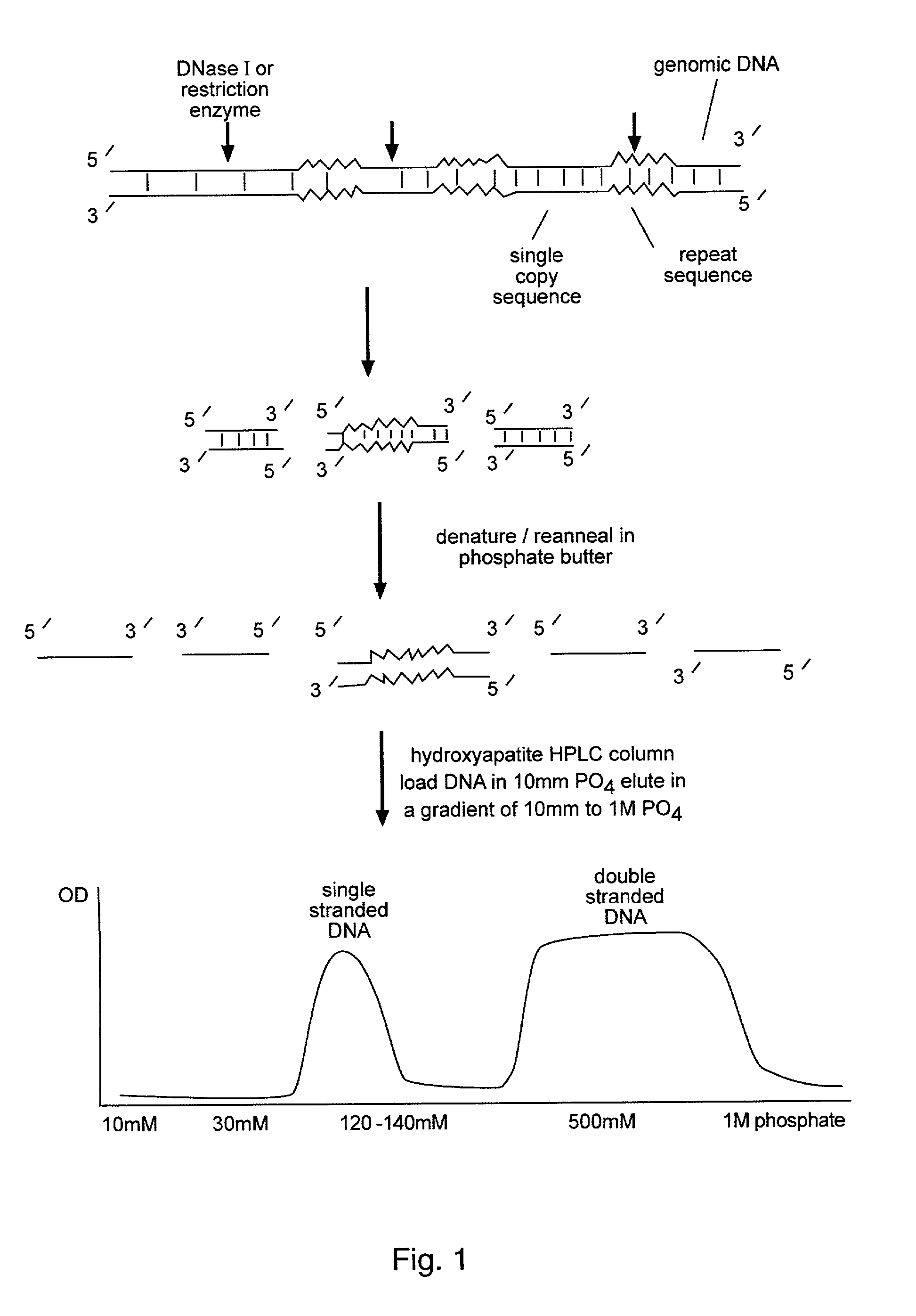Methods for reducing complexity of nucleic acid samples
a nucleic acid and complexity technology, applied in the field of nucleic acid complexity reduction, can solve problems such as complexity reduction, and achieve the effects of reducing the complexity of a population of nucleic acids, reducing the complexity of reduced complexity, and improving the signal to noise ratio of samples with less complexity
- Summary
- Abstract
- Description
- Claims
- Application Information
AI Technical Summary
Benefits of technology
Problems solved by technology
Method used
Image
Examples
example 1
Isolation of Cytoplasmic RNA from Tissue Culture Cells
[0077] In addition to using the methods of the present invention with cloned or genomic DNA, RNA may be used as a nucleic acid source for analysis. To prepare cytoplasmic RNA, cells were washed by adding 1 ml ice-cold PBS to a 10 cm tissue culture dish, and detaching the cells with a cell scraper. The cells were transferred to a 1.5 ml Eppendorf tube and centrifuged at 3000 rpm for 30 seconds. The supernatant was discarded and the cells were then suspended in 375 .mu.l ice-cold lysis buffer ( 50 mM Tris-Cl, pH 8.0; 100 mM NaCl; 5 mM MgCl.sub.2, and 0.5% (v / v) nonidet P-40) and incubated on ice for 5 minutes. The samples were then centrifuged, and the supernatants were removed and placed in clean tubes containing 8 .mu.l 10% SDS. 2.5 .mu.l of 20 mg / ml Proteinase K was then added to each tube and the samples were incubated at 37.degree. C. for 15 minutes. 400 .mu.l of phenol / chloroform / isoamyl alcohol was then added, the tubes were...
example 2
Second Strand cDNA Synthesis and Adapter Ligation
[0078] Once RNA has been isolated, cDNA may be prepared to be used in the methods of the present invention. First, 4 .mu.l 10.times.buffer (500 mM Tris-HCl pH 7.8, 50 mM MgCl.sub.2, 100 .mu.g BSA), 8 .mu.l 0.4 mM dNTP, 20 .mu.l first strand synthesis product, 2 .mu.l DNA polymerase I (20 U / .mu.l), 2 .mu.l RNase H (4 U / .mu.l), and water were combined and incubated at room temperature for one hour. Next, 10 .mu.l 5.times.buffer, 0.25 .mu.l DTT (100 mM) and 2 .mu.l T4 DNA polymerase (10 U / .mu.l) were added to the samples and incubated at 11.degree. C. for 30 minutes. One volume of phenol-chloroform was then added, the tubes were centrifuged, and the upper layer was extracted with an equal volume of chloroform. The DNA was precipitated with 12.5 .mu.l NaOAc (3M), 200 .mu.l EtOH (100%), and 12.5 .mu.l glycogen (500 .mu.g / ml) and overnight incubation at -20.degree. C. The DNA was then pelleted by centrifuging for 1 hour at 4.degree. C., the...
example 3
Biotin Labeling of Target DNA
[0080] Biotinylated residues were incorporated into target DNA using nick translation. The target DNA can be DNA prepared by PCR amplification or a previously cloned DNA fragment, and other preparations known to those skilled in the art. The reactions were prepared by combining 1 .mu.l purified DNA (0.1 mg / ml), 1 .mu.l biotin 16-dUTP (0.04 mM), 2 .mu.l 10.times.nick translation buffer (500 mM Tris-HCl (pH 7.5), 100 mM MgCl.sub.2, 50 mM DTT), 1 .mu.l dNTP mix (0.4 mM), [.alpha.-.sup.32P]dCTP (3000 Ci / mmole), 1 .mu.l DNAse I (10 mU), and water to 20 .mu.l. The reaction mixture was incubated at 16.degree. C. for 2 hours, then purified by spin column chromatography through Sephadex G-50 and ethanol precipitation. The pellet was resuspended in 10 .mu.l buffer.
PUM
| Property | Measurement | Unit |
|---|---|---|
| Tm | aaaaa | aaaaa |
| temperature | aaaaa | aaaaa |
| pH | aaaaa | aaaaa |
Abstract
Description
Claims
Application Information
 Login to View More
Login to View More - R&D
- Intellectual Property
- Life Sciences
- Materials
- Tech Scout
- Unparalleled Data Quality
- Higher Quality Content
- 60% Fewer Hallucinations
Browse by: Latest US Patents, China's latest patents, Technical Efficacy Thesaurus, Application Domain, Technology Topic, Popular Technical Reports.
© 2025 PatSnap. All rights reserved.Legal|Privacy policy|Modern Slavery Act Transparency Statement|Sitemap|About US| Contact US: help@patsnap.com



